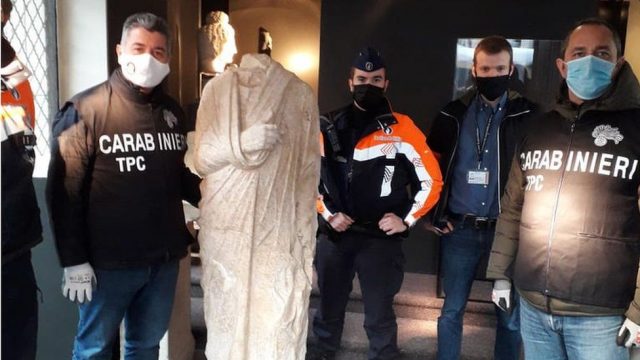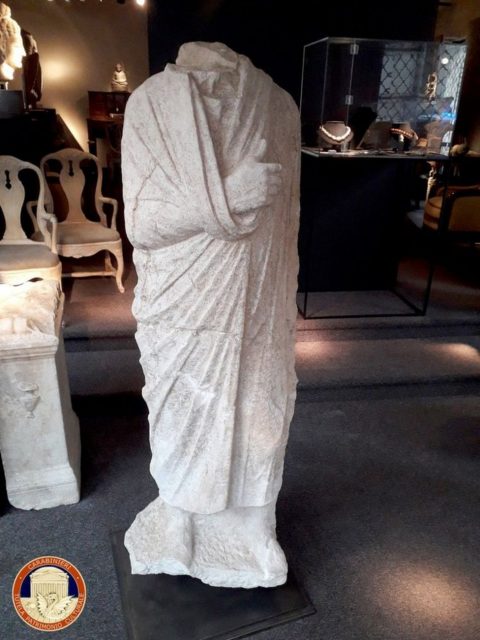Italian art detectives spotted a lost Roman statue looted 10 years ago. Where did they see it? In a Belgian antiques shop. And what’s more, the men were off duty at the time!
Crime never sleeps and art crime is no different it seems. Last month 2 members of the TPC (The Carabinieri Command for the Protection of Cultural Heritage) were in Brussels on other business.
Deciding to drop by an antiques store on their downtime, they noticed an intriguing sight. The headless, toga-clad statue – now identified as “Togatus” or “Civilian” – set alarm bells ringing for the pair. A quick database check revealed the surprising truth.
Togatus was spirited away from Italy’s Villa Marina Dettina archaeological site in 2011. The piece dates back to the 1st century BC. A reported price tag of $120,000 makes it a hot item in more ways than one.
As noted by NPR, the statue “bore the signature damage of excavation tools.”
The team took a picture of themselves with Togatus in early February. Detectives wore face masks. The statue didn’t require one for obvious reasons.

Investigations are focusing on one individual. BBC News describes them as an “Italian trader using a Spanish pseudonym”. The mysterious figure, who allegedly exported Togatus, has been referred to prosecutors.
Meanwhile, the statue is back in Italy. NPR reveals how Togatus was given an all over toga made of bubble wrap and tape.
The Associated Press talks about work undertaken by the TPC. Italian statues and other antiquities have “ended up in private collections, famous museums and commercial antique shops around the world.”
NPR writes that the TPC’s art-rescuing efforts span decades. As well as trafficking, they also move in during periods of natural disaster to retrieve priceless works. The outlet mentions that 137,000 pieces with an eye-popping value of $500 million were retrieved in 2014.
ARTnews reports on another success story for the Carabinieri. This concerned a painting by Nicolas Poussin that wound up in Nazi hands.
They also refer to a new book, ‘Ruling Culture: Art Police, Tomb Robbers and the Rise of Cultural Power in Italy’ by Fiona Greenland. Publicizing the tome, University of Chicago Press write that in seeking to take back control of its artifacts the country has “turned heritage into patrimony capital—a powerful and controversial convergence of art, money, and politics.”
In other news, the famous Torlonia Marbles are being displayed to the public in Rome. Seen for the first time in approx 70 years, the Marbles belong to the Torlonia family.
As reported by CBS News, this aristocratic clan built up a truly enviable collection of art across generations. 94 examples have been selected for viewing, though some 620 pieces are in the overall line up.
The scale of the display, kept behind closed doors for so long, has staggered experts. Quoted by CBS, archaeologist Darius Arya calls it “the greatest private collection of ancient Roman antiquity.”
Also noted is the collection’s status as “a history of restoration techniques.” How so?

“While, today, we’d leave fragments, in the past the style was to reconstruct what was missing.” In other words, 21st century experts look at pieces of the puzzle. Back then, they attempted to complete it themselves.
CBS writes that the process of getting the Marbles out into the wider world was a complex one. Dealings between the state and the family went into limbo, with factors such as cost and differing intentions cited.
A tantalizing glimpse at the treasures was provided by Prince Alessandro Torlonia in 1880. He produced a photographed and numbered catalogue where people could get an idea of what was largely hidden away.
Whether kept at home or recovered from looters abroad, Italian antiquity has become a fascinating slice of ancient history in the modern world.
Another Article From Us: These Important Ancient Cities are Lost to Time…Where Are They?
There is one outstanding question regarding the recovered Togatus. Good though it is to have it back in its rightful place, what on earth happened to the head? A case that arguably not even the TPC could crack…
